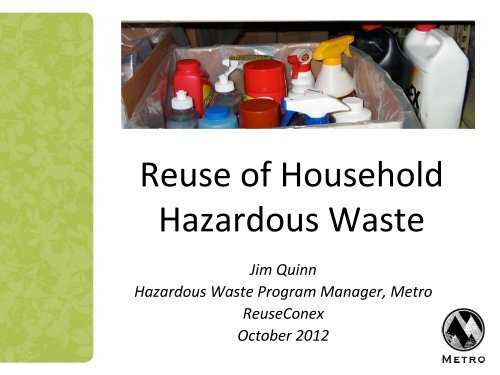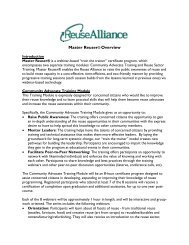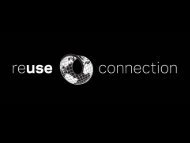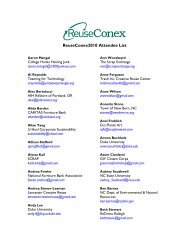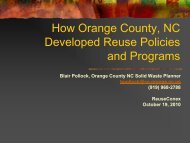Reuse of Household Hazardous Waste - Reuse Alliance
Reuse of Household Hazardous Waste - Reuse Alliance
Reuse of Household Hazardous Waste - Reuse Alliance
You also want an ePaper? Increase the reach of your titles
YUMPU automatically turns print PDFs into web optimized ePapers that Google loves.
<strong>Reuse</strong> <strong>of</strong> <strong>Household</strong><br />
<strong>Hazardous</strong> <strong>Waste</strong><br />
Jim Quinn<br />
<strong>Hazardous</strong> <strong>Waste</strong> Program Manager, Metro<br />
<strong>Reuse</strong>Conex<br />
October 2012
Metro’s Program<br />
• Metro is the regional government<br />
here in the greater Portland area<br />
• Metro’s HHW program serves about<br />
60,000 customers annually<br />
• We handle more than 4 million<br />
pounds <strong>of</strong> waste annually<br />
• All latex paint collected goes to our<br />
latex recycling program
HHW <strong>Reuse</strong> Programs<br />
• Also known as “Drop & Swap”,<br />
Materials Exchange, etc.<br />
• Are a “win/win/win”<br />
‣ good for the program: reduced<br />
disposal costs<br />
‣good for the community: useful<br />
products at no cost<br />
‣good for the environment: reduced<br />
resource use, reduced disposal impacts
Recycling/reuse <strong>of</strong> HHW<br />
• About 40% <strong>of</strong> what we receive is<br />
latex paint, recycled into<br />
MetroPaint<br />
• Of the remaining waste about 6%<br />
is diverted to our reuse program<br />
(~150,000 pounds annually)<br />
• Overall about 80% <strong>of</strong> the HHW we<br />
receive is recovered in some wayreuse,<br />
recycle, or energy
HHW for reuse can include:<br />
– paint (oil‐based) and other building<br />
materials<br />
– automotive products<br />
– cleaning products<br />
– printing ink & supplies<br />
– laboratory and photography chemicals<br />
– pool chemicals<br />
– propane cylinders<br />
– fertilizers
What about liability???<br />
• The primary concern is product liability ‐<br />
product may be contaminated or mislabeled,<br />
cause harm<br />
• Secondary concern‐ does not perform as it<br />
should<br />
• There is liability for not having a reuse<br />
program‐ i.e. disposal liability<br />
• What about a signed disclaimer or waiver?<br />
‣ Does not eliminate liability<br />
‣ Informs<br />
‣ Waives implied warranty<br />
‣ Provides some defense
Guidelines to minimize liability<br />
• Limit what is given out<br />
‣What types <strong>of</strong> products<br />
‣Condition <strong>of</strong> container<br />
‣Verification <strong>of</strong> contents<br />
• Limit who it is given to<br />
‣All comers vs. limited recipients<br />
‣Is the product appropriate for the<br />
recipient?
Container Guidelines<br />
• All items must be in their original<br />
containers<br />
• All original labels intact and legible<br />
• Container must be in sound condition,<br />
with closures properly functioning<br />
• Sealed never‐opened containers are<br />
best, opened containers with half or<br />
more <strong>of</strong> the original contents<br />
remaining are OK
Container Guidelines (cont.)<br />
• In some cases we verify the contents<br />
‣visual examination<br />
‣tests such as pH and water solubility<br />
‣results must match what is expected for<br />
the product<br />
• When original manufacturer's seal still<br />
intact, no verification needed<br />
• Aerosols & similar containers need<br />
not be tested
Limit Types <strong>of</strong> Products<br />
• No products intended for use on the<br />
human body, e.g. shampoos‐ unless the<br />
container is sealed with original<br />
manufacturer's seal<br />
• No product that is intended to be eaten<br />
or taken internally<br />
• No product that is not currently available<br />
to consumers<br />
• No product that is deemed too hazardous<br />
for reuse‐ depending on experience and<br />
skill <strong>of</strong> the recipient
Pesticides<br />
Only those that are allowed on organic crops :<br />
• diatomaceous<br />
earth<br />
• silica gel<br />
• boric acid<br />
• insecticidal soaps<br />
• fish oil spray<br />
• bacillus<br />
thurengiensis<br />
• linalool<br />
• methoprene<br />
• neem<br />
• oil spray /dormant oil/<br />
horticultural oils<br />
• sulfur<br />
• lime‐sulfur<br />
• copper sprays<br />
• tanglefoot/sharpshooter<br />
• chrome yellow paint<br />
• anything with Safer or<br />
Ringer brand name<br />
• phermones
Organizations<br />
Habitat for Humanity<br />
Gleaners<br />
Golden Harvesters<br />
Rebuilding Together<br />
Schools, churches, camps<br />
Garden clubs<br />
Homeless shelters<br />
Animal shelters<br />
Artist’s groups, theaters<br />
etc., etc.
A Habitat for Humanity<br />
house every three years<br />
Habitat for Humanity sells materials<br />
donated by the <strong>Reuse</strong> Program in<br />
their Restore. Annual sales total<br />
$26,000, or one third the cost <strong>of</strong> a<br />
Habitat house.
Repackaging for <strong>Reuse</strong><br />
• Fertilizers<br />
‣Dry solid<br />
‣Water soluble solid<br />
‣Water soluble, acid‐loving<br />
‣Liquid<br />
• No weed & feed!
Jim Quinn<br />
<strong>Hazardous</strong> <strong>Waste</strong> Program Manager<br />
Metro<br />
503‐797<br />
797‐1662<br />
jim.quinn@oregonmetro.gov<br />
www.oregonmetro.gov<br />
Metro | Making a great place


